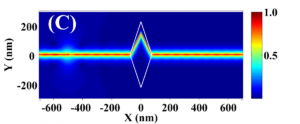Research expeditions:
- Efficient surface waveguiding via transformation optics and nonreciprocity
 I got interested in this problem during the first semester of his PhD at MIT, when we wrote a conference paper (A. Kumar, etal, Frontiers in Optics 2011/Laser Science XXVII, OSA Technical Digest (Optical Society of America, 2011), paper FMG7.) to propose a method to improve the performance of defect tolerant surface waveguides. This paper was presented at the Frontiers in Optics conference, San Jose in 2011. A natural extension of this work was to look at how by tuning surface impedances, one can prevent scattering of surface waves from sharp corners and protrusions: Transformation optics has proved to be a powerful technique to control propagation of electromagnetic waves. Numerous applications of this technique have been proposed and demonstrated. Some examples are invisility cloaks, waveguides with sharp bends, subwavelength image manipulation, etc. With the recent discovery of two dimensional materials such as graphene, there is an enormous interest in studying their optical properties. Such materials are usually characterized by a surface conductivity instead of the volume conductivity which describes the usual three dimensional materials. As such it is expected that the techniques of transformation optics, as is usually employed, will have to be modified to take into account the change in the dimensionality of the material parameter. To this end, for the first time, we formulated a fully general transformation optics scheme involving surface conductivity (Optics Letters, 39:2113, 2014).
I got interested in this problem during the first semester of his PhD at MIT, when we wrote a conference paper (A. Kumar, etal, Frontiers in Optics 2011/Laser Science XXVII, OSA Technical Digest (Optical Society of America, 2011), paper FMG7.) to propose a method to improve the performance of defect tolerant surface waveguides. This paper was presented at the Frontiers in Optics conference, San Jose in 2011. A natural extension of this work was to look at how by tuning surface impedances, one can prevent scattering of surface waves from sharp corners and protrusions: Transformation optics has proved to be a powerful technique to control propagation of electromagnetic waves. Numerous applications of this technique have been proposed and demonstrated. Some examples are invisility cloaks, waveguides with sharp bends, subwavelength image manipulation, etc. With the recent discovery of two dimensional materials such as graphene, there is an enormous interest in studying their optical properties. Such materials are usually characterized by a surface conductivity instead of the volume conductivity which describes the usual three dimensional materials. As such it is expected that the techniques of transformation optics, as is usually employed, will have to be modified to take into account the change in the dimensionality of the material parameter. To this end, for the first time, we formulated a fully general transformation optics scheme involving surface conductivity (Optics Letters, 39:2113, 2014).
